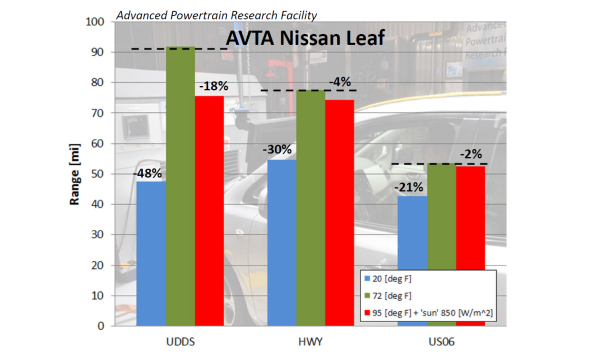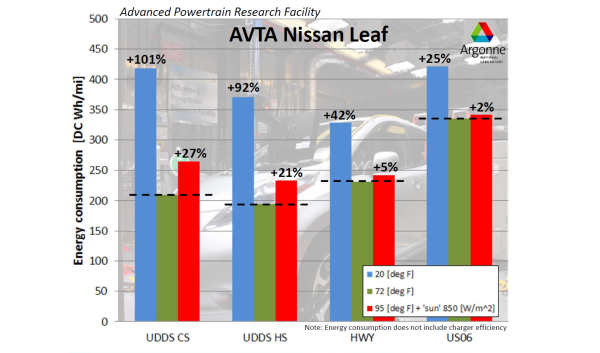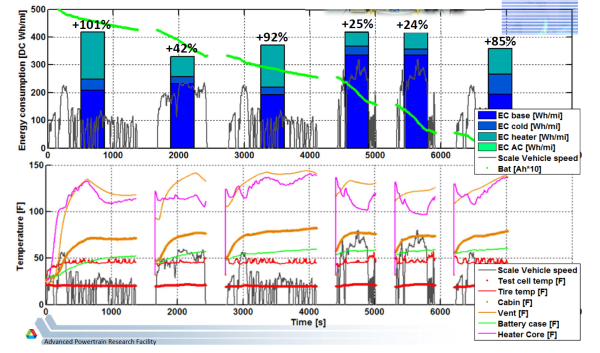The Tesla Model S Controversy: Understanding the Effects of Temperature on Electric Vehicle Efficiency and Range
by Vivek Gowri on February 18, 2013 4:22 PM EST- Posted in
- Auto
- Electric Vehicles
- Tesla Model S
- Nissan Leaf
Thermal Effects on Energy Consumption and Range
Looking at energy consumption, right off the bat, we can see that cold weather has a significant impact on EC - nearly double in urban driving, 40% more in the highway cycle, and 25% on the US06. It’s worth noting here: the Leaf has an 80 kW electric motor, a 24 kWh battery, and a 5 kW resistive heating element.
When broken down further, into a base load case (driving cycle EC at 72F), the amount of extra energy needed to drive the cycle at 20F (listed as EC cold), and then the heater load required to maintain a cabin temperature of 72F, we can see that a significant portion of the additional energy consumption is down to the heater. As with most gasoline cars, driving in sub-freezing temperatures only makes the car about 10% less efficient before heater loads are considered. The mechanically-driven heating elements in conventional vehicles add another 5% or so in terms of mechanical efficiency loss, while obviously the electric heater in the EV is far more costly from an energy consumption standpoint even though it doesn’t increase mechanical losses at all.
(Note: graphs were created by ANL using the raw 10Hz data instead of the filtered 1Hz data available on D3. Available as part of APRF's AVTA Nissan Leaf testing analysis and summary, as presented by Dr. Henning Lohse-Busch. Full presentation available here.)
And while energy consumption is a big deal, range is the be-all, end-all concern for most consumers. With the heater on, that’s a decrease in range by anywhere from 20-50% depending on your drive cycle. That’s a lot. And you can just look at the APRF’s full charge tests at 20F and 72F to see what I mean:
 Think about that - this is a car that, at launch, Nissan claimed had a 100 mile range. My own real-world driving suggests 80-85 a decent estimate. EPA says that number is closer to 73. The APRF’s instrumented testing backs that up (74.1 mile range at 72F), but the same instrumented testing, in 20F weather? 46 miles. That’s it.
Think about that - this is a car that, at launch, Nissan claimed had a 100 mile range. My own real-world driving suggests 80-85 a decent estimate. EPA says that number is closer to 73. The APRF’s instrumented testing backs that up (74.1 mile range at 72F), but the same instrumented testing, in 20F weather? 46 miles. That’s it.













102 Comments
View All Comments
Hulk - Monday, February 18, 2013 - link
While I'm a mechanical engineer it doesn't take much thought to understand that Tesla has a history of making claims that physics doesn't allow.Case in point. The Model S is lucky to get 3miles/kWHr. So if you drained the battery fully that would be 85x3=255 miles. Best case. But the reality is you'll kill the battery quite quickly discharging that deeply. A more realistic discharge is what GM claims with the Volt. It uses a 16kWHr battery and discharges to about 11kWHr. Or about a 70% discharge if you want the battery to last more than a few months.
255x.7=178.5 miles. That is the real long-term viable range of the S.
I have argued this with a Tesla engineer and all he can tell me is that they have "super secret special battery technology" or some other BS.
There is nothing wrong with this range either. But Tesla should be up front about the numbers.
Scootiep7 - Monday, February 18, 2013 - link
You hit the nail on the head in this article. I live in Iowa and own a Hybrid Escape. In the spring and fall it's great. 31-33ish MPG (wife has a bit of a lead foot, up to 35 when I drive it =D). And in the summer it's not bad, generally 28 - 32. But as soon as we hit late fall and throughout winter, FORGET ABOUT IT! We're averaging 23 mpg. And it's no better (in fact worse) in two of my friends Prius's. Electric cars simply aren't practical for cold weather and Hybrid vehicles currently don't live up to the hype in these conditions either. It regularly dips down into the 20 to -10 range here and occasionally hits -25 (most recent record was -36 four years ago). My point being, if you want to sing the praises about these cars and the wonders they do for "mother earth" and can save you enough to buy a small house, by all means, go for it. But don't outright lie about them to get people to buy them. At the same time, my 1997 Olds Cutlass Supreme still gets the same 20mpg city, 25 hwy it's been getting since I got it 11 years ago with 124k miles on it then and 176k miles on it now. It puts out heat and AC, drives the same range and takes less than 2 minutes to go from empty to a full tank no matter what the weather. That kind of convenience and practicality is something we simply can not offer in an electric vehicle at this point in time. Should we keep developing them? ABSOLUTELY! But should we start lying about them to get people to buy them? Good God no.And the sad thing is that it's the same with ALL eco friendly products. Take CFL bulbs for instance. Supposed to save on average 4 times the electricity over a conventional blub and last around 10 times as long. And in an ALWAYS ON situation they work GREAT! But in a regular residential dwelling? AGAIN, FORGET ABOUT IT! I have 4 large ziploc bags in my basement full of CFL's with dead ballasts because the lights are frequently turned on for only brief periods during the evening and morning and then switched back off whenever we leave a room or the house to go to work. In my experience, they have actually died FASTER than regular incandecents. AND FOR FIVE TIMES THE COST!
The testing methods on ALL of these kinds of products needs to undergo some very, very harsh scrutiny and change radically. I couldn't agree with you more Gowri.
...Oh damn it, locked my "rant" key up again. I apologize.
gauss jordan - Wednesday, February 20, 2013 - link
Conventional cars don't work all that well either in cold weather, but people is more used to those problems. And usually amply supplied with blissful ignorance.The oil does not flow as it should before it is warm enough. A cold engine cause humidity to form on the cylinder walls which end up in the sump, where it changes into acid. The probability that the engine don't start at all increases a lot. And so on ...
For short trips EV's have some user benefits, like instant heating of the windscreen, instantly ready to drive after it is "started" ... , but as most technologies, with the benefits you also get the "costs"
CFLs should be banned. It really irks me when I see them promoted as eco friendly. Each CFL bulb contain more than 3 mg mercury!
Because the CFLs does not irradiate infrared light, the air temperature must be higher for the same level of comfort, and therefore CFLs often contribute to significant _higher_ total energy consumption (in the parts of the world where heating is necessary.
It should be mentioned that the same corporations that lobby for CFL bulbs, reduced the longevity of light bulbs from 2500h to 1000, on purpose. Now a 2500h bulb is regarded as "long life".
mtwardochleb - Monday, February 18, 2013 - link
Any comparison of range between the Leaf and Model S in cold weather is meaningless if you don't discuss the differences in their thermal management.The Leaf's battery pack is air-cooled, resulting in cells reaching temperatures that are far too low or high to operate efficiently in exceptionally cold or hot climates.
Tesla's battery pack is both cooled and heated by a liquid thermal management system, maintaining cells at their optimal temperature, regardless of climate.
Active thermal management of the battery pack is how Model S maintains its range in cold weather. It does degrade, but not by 50%.
VivekGowri - Monday, February 18, 2013 - link
So, I didn't really want to speculate on the actual range effect on the Tesla would be in numerical terms, which is why I just left it as "the numbers will be different for a variety of reasons". Not only because of the liquid-cooled battery pack, but also because the heating element would likely be a lesser auxiliary load relative to the powertrain energy consumption when compared to the Leaf. Now, with that said, the principles are exactly the same.flyingpants - Tuesday, February 19, 2013 - link
But you did speculate on the actual range effect on the Tesla. On page 3, paragraph 1, you said "In cold or near-freezing weather, with the heater running, I would not be that surprised to see range fall to something in the 180 mile region."That's a 32% drop. Why make up numbers? Why not instead find someone (anyone, maybe a Tesla forum user) who has actually done a mileage test at 20F?
Why does the title of the article mention the "Model S", and all the data is about the Leaf? This is misleading at best.
Doesn't Anandtech generate over $1m/yr in revenue? Since you and Anand both agree EVs need more/better testing, why not take the initiative and actually test a Model S yourselves?
:)
mtwardochleb - Tuesday, February 19, 2013 - link
Yes, you did speculate with hard numbers exactly where flyingpants said. Why?Also, if you're able to acknowledge the effects of active thermal management and the smaller relative load of the heating element in such a concise manner in the comments, why can't you mention it in the article?
What principles are the same? We're now talking about a battery pack that's actively managed, trading the temperature-based efficiency loss for a small heating loss, and a smaller heater relative to the motor (which draws an even smaller fraction of available power compared to the Leaf thanks to the battery operating more efficiently), so the Model S is operating on an entirely different range vs temperature curve. If you're saying that aerodynamics and friction remain the same, of course, but we're talking about how well the car copes with cold weather, and those two factors are what determine it for these cars.
milkylainen - Tuesday, February 19, 2013 - link
Speaking from one who lives in a northern country and I have had fuel based heaters in my cars for quite some time now.An electric drive-train should be doing just propulsion and minor electric stuff that can't be done without electricity.
Cabin heat in freezing temperatures SHOULD come from a fuel based heater. Volvo recently showed off a all electric drive-train which had solved cabin heat by using a renewable alcohol fuel based heater. Burning hydrocarbons to create heat is something fuel is great at.
Consumption is like an eight of a gallon per hour. Charging your electric car to burn all that precious electricity to create waste heat is just stupid.
Base heat on some renewable hydrocarbon source instead of getting range anxiety in freezing temperatures.
That's how you combine technology.
Omophorus - Tuesday, February 19, 2013 - link
My biggest beef with the whole EV thing is that Tesla LOUDLY (LOUD NOISES!!!!) proclaims that there are "no compromises" versus a regular car.Obviously, that's bunk. You have to completely change your driving style, your expected trip duration (especially for longer trips) and very carefully plan your route on long trips to be near Supercharger stations if you want to go any real distance.
And, frankly, if I'm limited in where I can go, and limited in how i can drive, I really have a hard time justifying embracing EV tech. I think the infrastructure and products will improve, and the current Tesla model range is an important step in that process, but anyone who buys one as anything except a toy is completely bonkers insane (or never, EVER drives long distances).
Most appallingly, to actually be able to use the Tesla, you can't use it. It's a "sport sedan" in the same vein as a 5 series BMW or a Porsche Panamera, but you can't do anything sporty with it if you actually want to go any real distance. If you're just tootling about locally, you're fine, but you wouldn't be able to do something like, say, leave the Triangle in NC and head out for a blast on the Blue Ridge Parkway. You'd be out of juice in the middle of nowhere and SOL. And, if I'm honest, there are very few reasons to even want to bother living in NC (having done it myself) besides the ability to spend a spring or fall day on said BRP to enjoy the sites and one of the truly fantastic roads in America.
Death666Angel - Tuesday, February 19, 2013 - link
Interesting write up. Couple things though. :DTo say: "The world of electric vehicles is still very new to the automotive industry, the tech industry, and the mainstream consumer." Is not that accurate. Electronic engines have been around for over a century. Many car companies sold electronic vehicles in the 90s. Just because some people are unaware of certain things does not mean those things are new. :)
Most of what you said here makes me go "duh". The interesting thing in this for me is whether the journalist is trustworthy or if he has a different agenda. So the article doesn't really help me shine a light on what is going on with regards to that. :/
What will play a role in changing the perception of EVs is when they will be charged like normal cars in 5 minutes. 90kW isn't bad for the supercharger, but it's still cumbersome. When we can refuel the electrolyte, EVs will be seen in a better light. :)